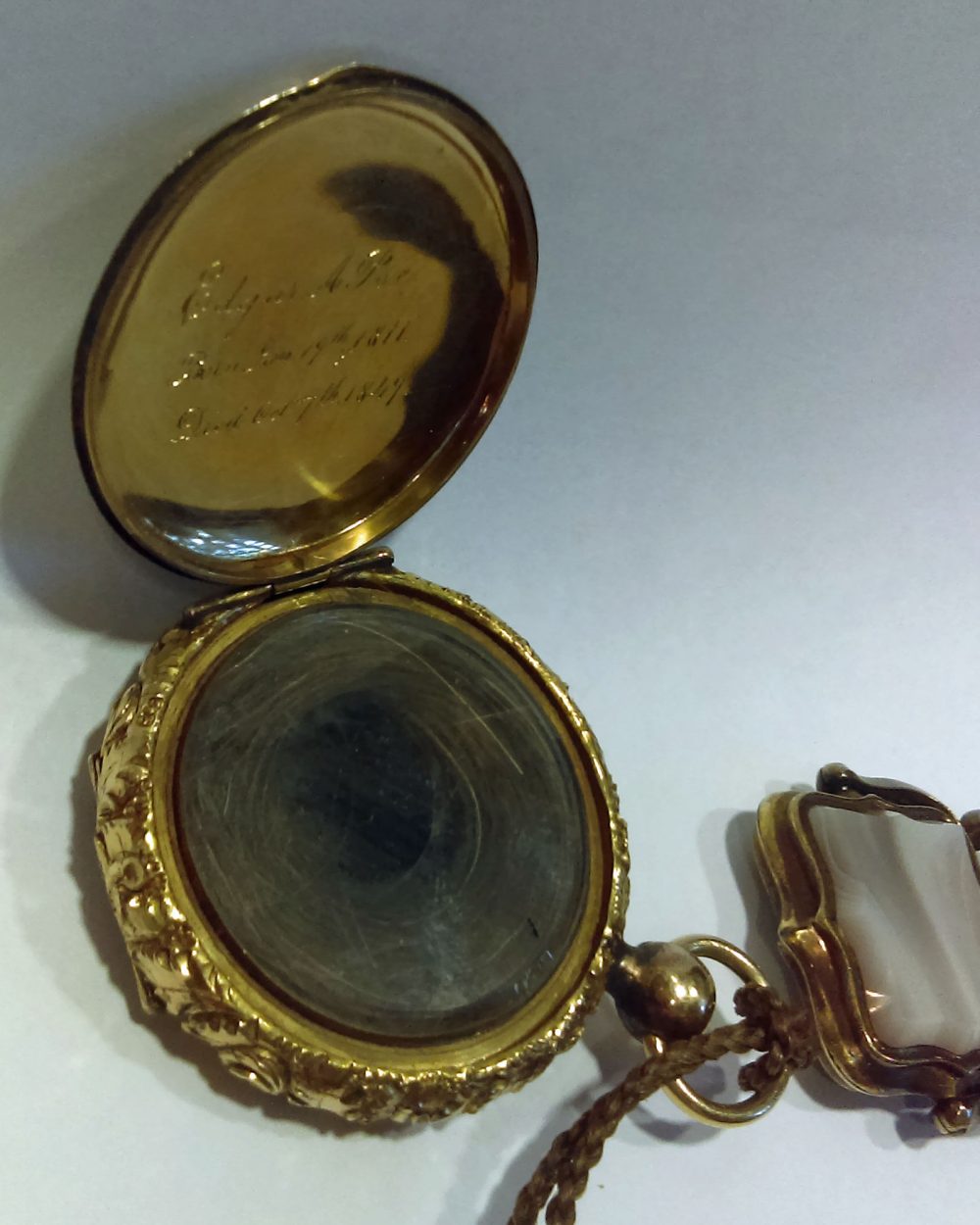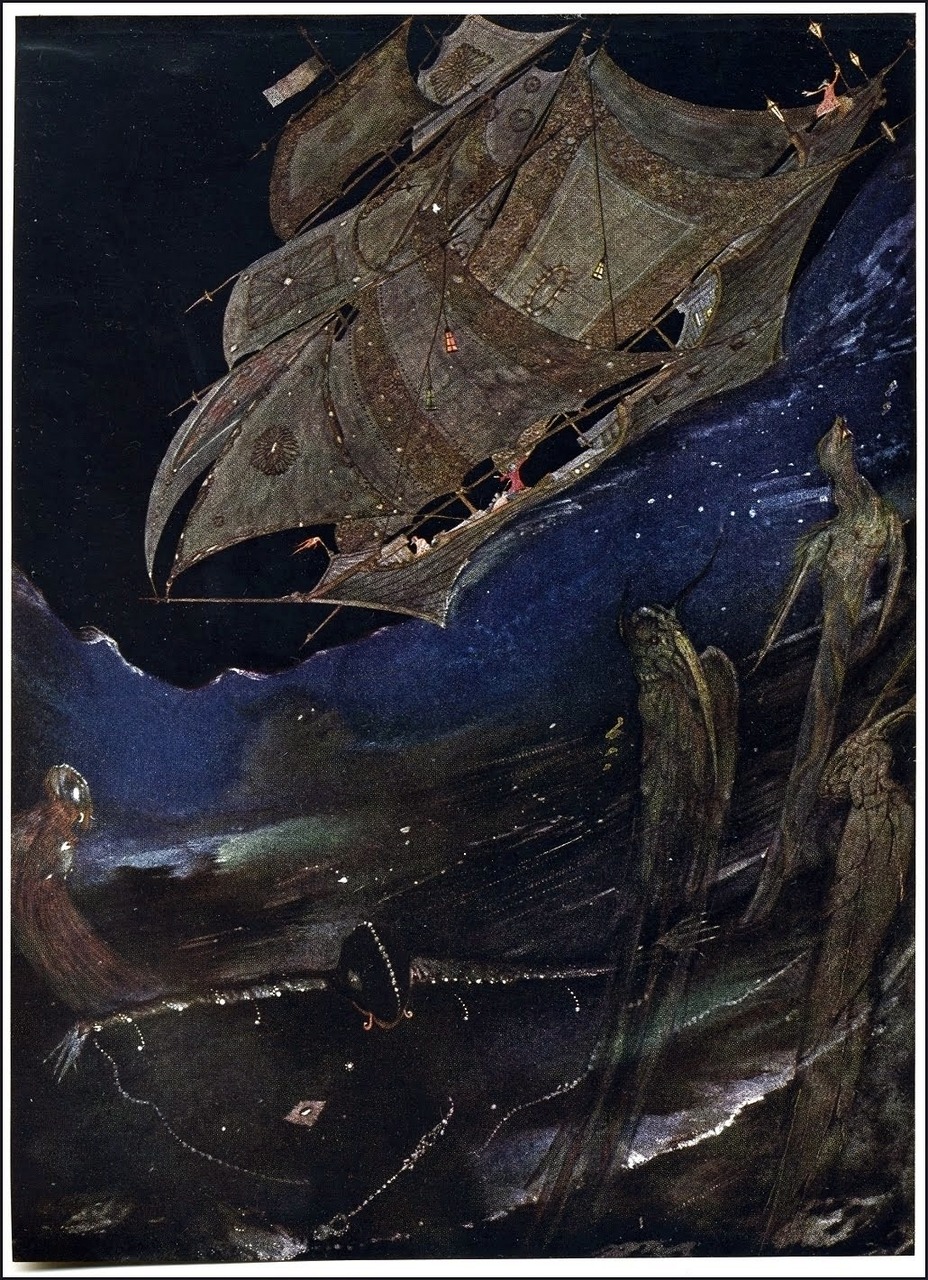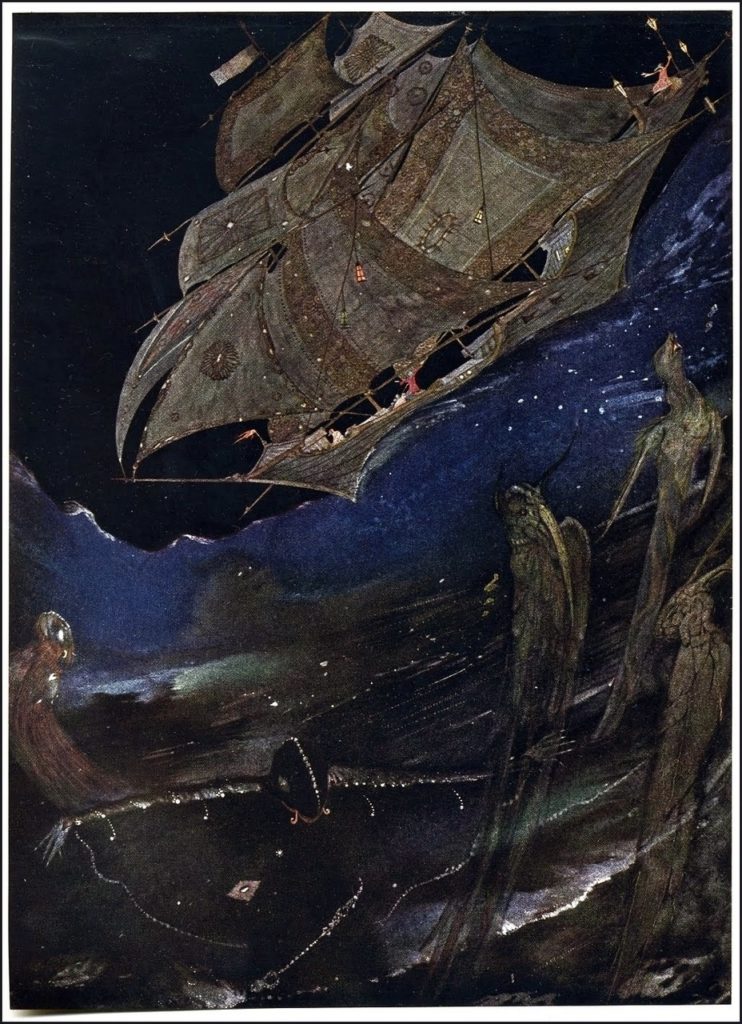The votes are in, and the loser is…Daniel Payne.
During the Poe Museum’s recent exhibit CSI: Poe, we asked our guests to help solve the murder of Mary Rogers. Back in 1841, the case stumped the authorities, so Edgar Allan Poe tried his hand at solving it. Here is a little background on the case:
Mary Rogers
The Victim
Mary Cecelia Rogers
(1820-1841)
The lovely Mary Rogers made waves in New York when she took a job in Anderson’s Cigar Emporium. At a time when proper ladies did not work in public, Rogers became a public figure renowned for her beauty, and men from across the city came to visit Anderson’s store to flirt with her.
Timeline of Events
1837
Seventeen-year-old Mary Cecilia Rogers and her widowed mother Phoebe Rogers moved to New York City where Mary made waves by taking a job in Anderson’s Cigar Emporium. At a time when “proper ladies” did not work in public, Rogers became a public figure renowned for her beauty, and men from across the city came to visit Anderson’s store to flirt with her. One of these gentlemen said he spent an entire afternoon in the store just to exchange glances with her, and another dedicated a poem to her.
October 4, 1838
Mary Rogers disappeared, leaving a suicide note. Her fame as the “Beautiful Cigar Girl” at Anderson’s Cigar Emporium caused the New York papers to report the event. Then, just as mysteriously as she departed, she returned the next day. The New York Sun reported that her supposed disappearance had merely been a hoax. Later that year, Mary quit working at Anderson’s Cigar Emporium and went to help her mother, who had purchased a boarding house.
1841
June
Mary Rogers’s Engagement
In June 1841, Mary Rogers engaged herself to the cork-cutter Daniel Payne. Alfred Crommelin, a rejected suitor who was living in Phoebe Rogers’s boardinghouse, quickly moved out of the house, telling Mary that she could contact him if she were ever in danger.
July 25
Early on Sunday morning, Daniel Payne walked his fiancée Mary Rogers to the omnibus. She told him she intended to ride across town to see relatives and would return later that day. Payne was to have met her at that time to walk her home. A summer storm drove him into a bar in which he spent the afternoon, missing his appointment.
July 28
The Discovery of the Body
When Mary did not return home, Alfred Crommelin led a search for her. After looking for her in Manhattan, he crossed the Hudson River to Hoboken, a popular resort town for New Yorkers escaping the heat of the crowded city. Shortly after his arrival in Hoboken on July 28, three men in a rowboat found a woman’s body floating offshore near Sybil’s Cave. They carried the body to the shore, where it lay decomposing in the hot sun for an hour before the magistrate arrived. The coroner performed a cursory examination of the body and determined that the victim had been strangled with a cord that was still tied around her throat.
Some newspaper reporters doubted that the badly decomposed corpse found in Hoboken was even Mary Rogers. After all, her face was unrecognizable by the time she was pulled from the river. They speculated that Mary had simply eloped and settled in some other part of the country. Her former suitor Alfred Crommelin had identified her by her arm hair and by her clothing.
1841-1842
The Investigation
At the time of Mary’s murder, New York City Police Department did not yet exist. Instead, the city of over 300,000 was protected by a system of a hundred city marshals, about thirty constables, and a volunteer night watch responsible for patrolling the city in order to prevent crime. Once a crime had been committed, the best available investigative technique consisted of interrogating as many suspects as necessary until a confession could be obtained. Since Mary was reported missing in New York while her body was found in Hoboken, both city’s magistrates fought over who had jurisdiction in the case. After the New Jersey coroner performed an autopsy and buried the remains in Hoboken, the New York coroner had her badly decomposed disinterred and carried across the Hudson for a second autopsy days later. Four years later, dogged both by its failure to identify Mary’s killer and by its inability to control increasingly rowdy Christmas celebrations, New York City replaced its volunteer patrol with a police force of 1,200 salaried officers.
August
About a month after the discovery of Mary’s body, two boys claimed to find some of her clothing in a nearby thicket. A sketch of the thicket appeared in the New York Tribune. The boys were later identified as the sons of Frederica Loss, the operator of a Hoboken roadhouse where vacationers came for drinks during their visit to the river-side resort. Although many believed the thicket to be the site of the murder, Poe thought the scene might have been staged. Suspicion fell of the Loss boys when it was discovered that it was in Mrs. Loss’s roadhouse that Mary was last seen alive.
October 7
Suicide of Daniel Payne
About three months after Mary’s death, her fiancé Daniel Payne visited Hoboken and committed suicide on the spot at which he believed Mary had been murdered. He left a note saying, “To the World – here I am on the very spot. May God forgive me for my misspent life.”
1842
June 1842
Poe Tries to Find a Publisher for His Theory
While living in Philadelphia, Poe followed the Mary Rogers case in the newspapers and became increasingly frustrated with the magistrates’ inability to capture the killer. By June 1842, he had written his own solution in the form of the short story “The Mystery of Marie Roget,” in which he believed he had “indicated the assassin in a manner which will give renewed impetus to [the] investigation.” As he wrote editor Joseph Snodgrass, Poe envisioned his story would instruct police forces in the science of solving crimes by demonstrating “an analysis of the true principles which should direct inquiry in similar cases.” Magazines in Baltimore and Boston rejected the story before Poe finally found a publisher.
Weehawken, where the body was found
November 1842
Poe publishes the first installment of “The Mystery of Marie Roget”
William Snowden, editor of the New York-based Ladies’ Companion, had contributed to a reward to be offered to anyone who could identify Mary’s murderer. It was likely his personal interest in the case that led Snowden to publish Poe’s story “The Mystery of Marie Roget” to (in Poe’s words) “give renewed impetus to [the] investigation.”
Although he let everyone know his story was based on a true crime, Poe was certain to change the names and locations to protect the innocent—and possibly to protect himself from a libel suit. Here is a guide to which character in the story represents each person in the case:
Reality Fiction
Mary Rogers = Marie Roget
Phoebe Rogers = Madame Roget
Mr. Anderson = Monsieur Le Blanc
Alfred Crommelin = Monsieur Beauvais
Daniel Payne = Monsieur Jacques St. Eustache
Frederica Loss = Madame Deluc
The tale was so long that Snowden decided to publish it in three installments. The same month the first installment appeared Frederica Loss died, supposedly telling a magistrate that Mary had died during a botched abortion. The new evidence caused Poe to rewrite the second and third installments to avoid being proven wrong.
February 1843
Poe Publishes Final Installment of “The Mystery of Marie Roget”
Just as readers reached the final paragraphs of the last installment of “The Mystery of Marie Roget” in the February 1843 issue of Snowden’s Ladies’ Companion, expecting the revelation of the murderer’s identity, they instead saw the narrative interrupted by a note from the editor explaining why the killer’s name could not be printed. The note reads, “For reasons which we shall not specify but which to many readers will appear obvious, we have taken the liberty of here omitting, from the MSS. placed in our hands, such portion as details the following up of the apparently slight clew obtained by Dupin. We feel it advisable only to state, in brief, that the result desired was brought to pass; and that an individual assassin was convicted, upon his own confession, of the murder of Marie Rogêt, and that the Prefect fulfilled punctually, although with reluctance, the terms of his compact with the Chevalier. Mr. Poe’s article concludes with the following words. — Eds.” The suggestion was that the name was being suppressed either to avoid a libel suit or to protect someone of influence.
Literary scholars, however, believe Poe wrote this fake note himself in order to allow him to claim he had solved the mystery without actually having to solve it. Five years later, Poe supposedly told his fiancée Sarah Helen Whitman that the killer was a Naval officer named Spencer.
The Suspects
Daniel Payne
Payne was a heavy drinking, violent cork cutter. Although Mary’s mother did not approve of him (or because of it), Mary accepted his marriage proposal. Daniel admitted that he went to a bar instead of walking Mary home after her visit to relatives, and police accepted his alibi. One month after her death, he visited Hoboken and committed suicide on the spot at which he believed Mary had been murdered.
Alfred Crommelin
Crommelin, who listed his profession as “gentleman,” was a tenant in Phoebe Rogers’s boardinghouse when he became infatuated with Mary. Although he stormed out of the house after seeing Mary and Daniel engaged in indiscreet behavior, he later told Mary she should contact him if she ever felt she was in danger. The week she disappeared, Mary left a rose in Crommelin’s office. He was out of his office when she left her gift, and he did not understand what it meant.
John Anderson
John Anderson owned a successful New York City cigar store, which eventually employed Mary Rogers. His bold decision to flaunt respectability by hiring a beautiful woman may have been controversial, but it was great for business. After the death of Mary Rogers, critics blamed him for exposing her to the temptations that led to her death, but police ruled him out as a suspect. Some critics theorized that Poe, who knew Anderson, wrote “The Mystery of Marie Roget” to protect Anderson from implication in the murder.
Later in life, Anderson achieved enormous wealth by selling chewing tobacco wrapped in tinfoil for freshness to prospectors on their way to California. When asked to run for mayor of New York, he declined because he thought his association with the Mary Rogers case would prevent him from being elected. Later in life, Anderson became a Spiritualist and believed Mary’s ghost followed him, acting as an advisor. He is said to have cried out to her from his deathbed.
A Gang of Hoodlums
The sons of Frederica Loss reported they had seen a gang of hoodlums in their mother’s roadhouse on the night of Mary’s visit. The boys also claimed to hear a woman’s scream coming from a nearby thicket later that evening. Lacking any other solid leads, the magistrate blamed her death on an unspecified gang of Irish immigrants, and this became the accepted explanation. This became the accepted theory of her death for over a year, but Poe ruled out the theory, instead speculating that a lone killer was responsible.
In 1842, the boys later accidentally shot their mother, who on her deathbed, is said to have blamed Mary’s death on a botched abortion that may have taken place in her house. The police, however, dismissed this “confession” as a hoax.
Madame Restell
When newspapers reported that the widow Loss, on her deathbed, implicated an abortionist in Mary’s death, the well-known New York City abortionist Madame Restell was blamed. She was arrested multiple times for performing illegal abortions but always paid her fines and was released. At one point, an angry mob surrounded her house shouting, “What happened to Mary Rogers?” It was later revealed that she was not even home because an informant on the police force had warned her in advance to flee. Despite public opinion, Restell was never really a suspect, and the magistrate to whom the Widow Loss had supposedly confessed later stated the confession had been a cruel hoax. In 1878, Restell returned home one afternoon, drew a bath, and slit her wrists.
Who do you think murdered Mary Rogers? Payne? Crommelin? Spencer? Somebody else? We asked visitors to the exhibit to cast their votes, and they decided that Daniel Payne was the winner (or loser). Here are the results:
Daniel Payne 31%
Alfred Crommelin 30%
A Gang of Hoodlums 9%
Madame Restell 9%
A Botched Abortion 6%
Fredericka Loss’s Sons 6%
John Anderson 4%
It wasn’t Mary’s body! 4%
Poe Museum Curator Chris Semtner 1%
 Stephen Macko is a Professor of Isotope and Organic Geochemistry in the Department of Environmental Sciences at the University of Virginia. He has authored over 300 refereed research papers and books including the singular work in the field, Organic Geochemistry. He was elected a Fellow of the Geochemical Society and of the European Association of Geochemistry and was a Corresponding Editor for EOS, the publication of the American Geophysical Union. He recently held the position of Program Officer for Geobiology and Low Temperature Geochemistry at the US National Science Foundation.
Stephen Macko is a Professor of Isotope and Organic Geochemistry in the Department of Environmental Sciences at the University of Virginia. He has authored over 300 refereed research papers and books including the singular work in the field, Organic Geochemistry. He was elected a Fellow of the Geochemical Society and of the European Association of Geochemistry and was a Corresponding Editor for EOS, the publication of the American Geophysical Union. He recently held the position of Program Officer for Geobiology and Low Temperature Geochemistry at the US National Science Foundation.



